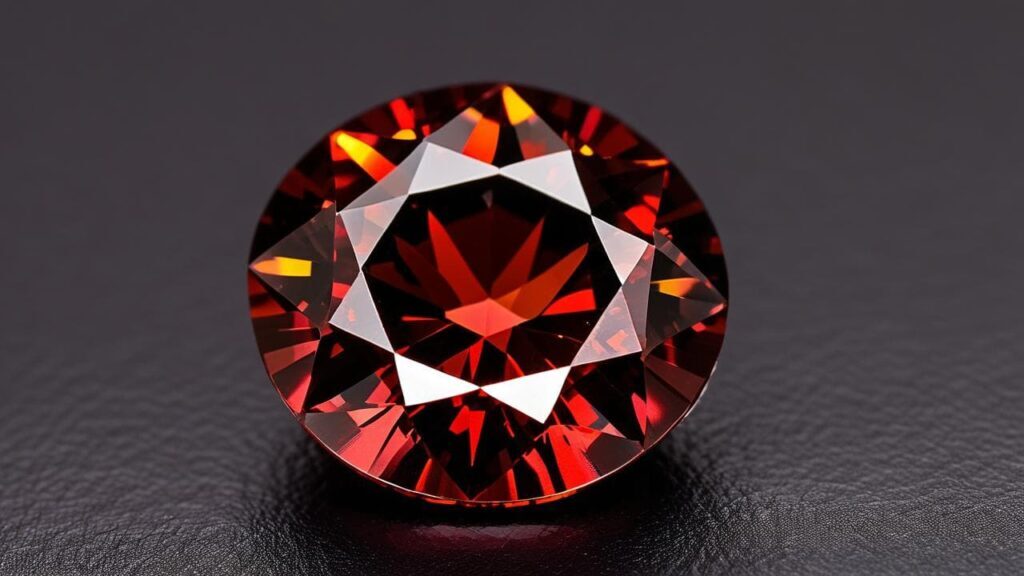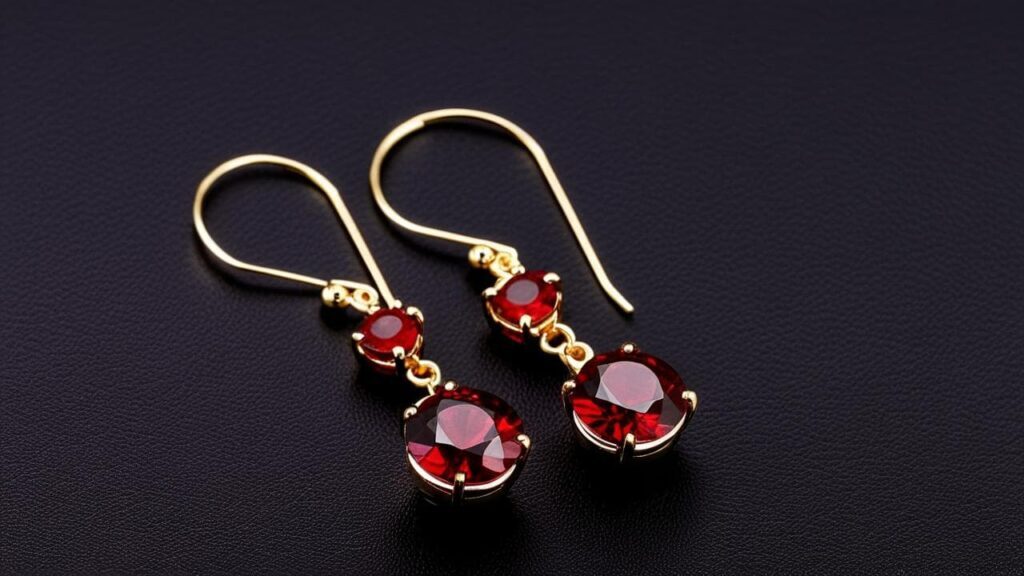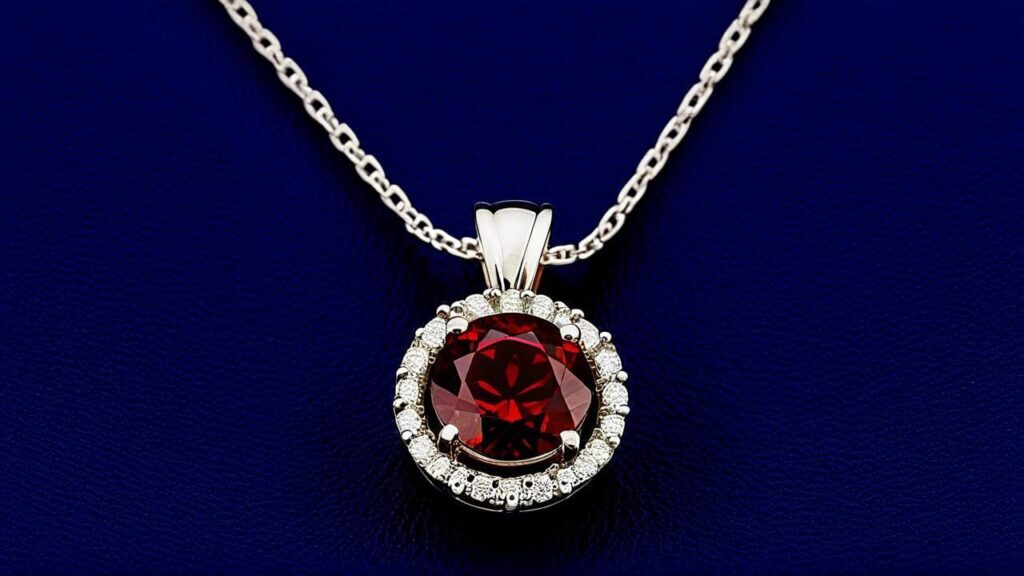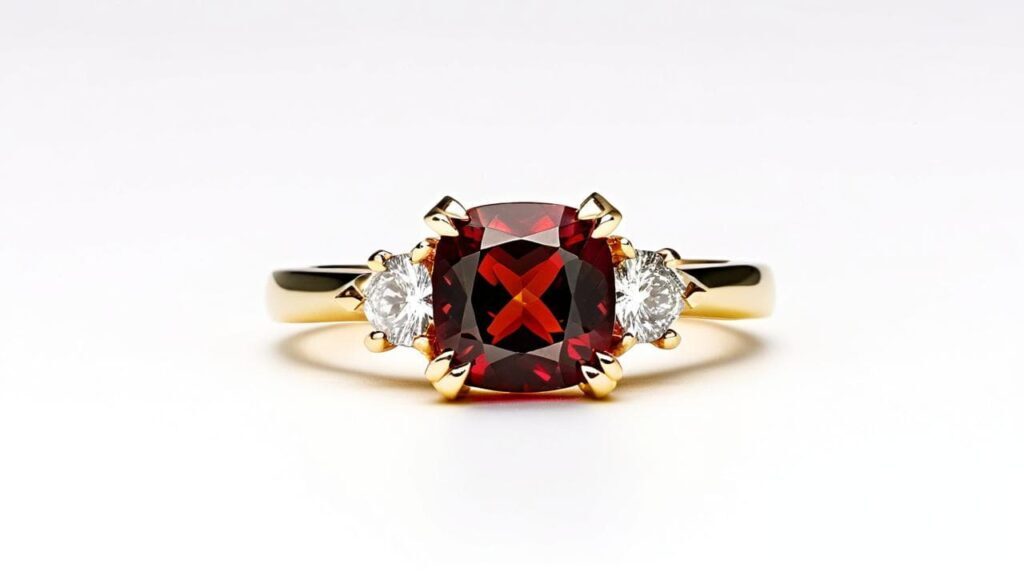Pyrope is one of the most prized varieties of garnet, beloved for its deep red color that has captivated gem enthusiasts for centuries. Often mistaken for ruby due to its rich crimson hue, pyrope has its own unique properties and characteristics that make it a valuable addition to any jewelry collection. From its physical properties and formation to its historical significance and place in modern jewelry, pyrope garnet offers a fascinating blend of beauty, durability, and cultural importance that continues to make it a favorite among gemstone collectors and jewelry wearers alike.
Understanding Pyrope
Pyrope garnet gets its name from the Greek word “pyropos,” meaning “fire-eyed,” a reference to its intense red color that seems to glow from within. As a member of the larger garnet family, pyrope is distinguished by its deep red to slightly purplish-red color and exceptional clarity compared to other garnet varieties. It belongs to the garnet group of silicate minerals and is one of the few gemstones that occurs almost exclusively in its red form without requiring any treatments or enhancements.
- Pyrope is a magnesium aluminum silicate with the chemical formula Mg₃Al₂(SiO₄)₃, making it one of the six common species in the garnet group. The high magnesium content is what distinguishes it from other red garnets like almandine, which contains iron instead.
- The color range of pyrope spans from deep blood red to darker reddish-purple, with the most valued specimens showing a pure red with slight purple undertones. This color comes naturally without any treatment, unlike many other gemstones that require heating or irradiation to enhance their appearance.
- While pure pyrope is rare in nature, it commonly forms solid solution series with other garnet species, particularly almandine and spessartite, creating intermediate varieties with blended properties. The rhodolite garnet, a pinkish-purple variety, is a well-known mixture of pyrope and almandine.
Pyrope’s popularity has endured throughout history, from ancient Roman adornments to Victorian jewelry to modern fashion pieces. Today, it continues to be appreciated for its affordability compared to rubies while offering comparable beauty and superior durability to many other red gemstones, making it both a practical and attractive choice for everyday jewelry wear.
Physical Properties of Pyrope

Pyrope garnet possesses a combination of physical properties that make it particularly well-suited for jewelry applications. Its excellent hardness, high refractive index, and isotropic optical character (meaning it reflects light evenly in all directions) contribute to its enduring popularity among jewelers and gemstone collectors. These inherent qualities allow pyrope to maintain its beauty with minimal special care.
- Hardness and Durability: Pyrope ranks 7 to 7.5 on the Mohs hardness scale, making it resistant to scratches from everyday objects and suitable for all jewelry types, including rings that encounter frequent impact. Unlike softer gemstones that quickly show wear, pyrope maintains its polish and facet edges over years of regular use.
- Optical Properties: With a refractive index of 1.73 to 1.76 and dispersion of 0.022, pyrope displays excellent brilliance and fire, though not as pronounced as diamond. Its isotropic nature means it doesn’t split light into different paths, resulting in consistent sparkle from all angles without the need for precise orientation during cutting.
- Structure and Toughness: Pyrope has no cleavage planes (internal weakness directions) and instead breaks with a conchoidal (shell-like) fracture, making it relatively resistant to chipping. This lack of structural weakness, combined with its hardness, contributes to pyrope’s excellent durability in jewelry.
- Density and Heft: With a specific gravity of 3.58-3.78, pyrope has a satisfying weight in hand—noticeably heavier than many other gemstones of similar size. This property helps gemologists distinguish pyrope from look-alikes and contributes to its substantial feel in jewelry settings.
- Clarity and Transparency: High-quality pyrope typically shows excellent transparency and clarity with minimal inclusions, allowing maximum light return and brilliance. This clarity is a distinguishing feature that separates it from many almandine garnets, which tend to have more inclusions.
The combination of these physical properties means that pyrope jewelry maintains its beauty over time with reasonable care. Unlike softer gemstones, pyrope doesn’t easily scratch or lose its polish, and its lack of cleavage makes it resistant to chipping during normal wear. These characteristics make pyrope garnet not just a beautiful choice, but a practical one for jewelry that’s meant to be worn regularly.
Pyrope’s Chemical Composition and Formation
Pyrope forms under specific geological conditions that determine its pure color and crystal structure. Its formation requires high pressure and the presence of particular mineral elements, which explains why it’s often found in association with diamond-bearing rocks and certain metamorphic environments. The chemical composition directly influences both its color and its physical properties.
- Chemical Formula and Structure: Pyrope has the chemical formula Mg₃Al₂(SiO₄)₃, with magnesium as the dominant element that distinguishes it from other garnet varieties. This composition creates a cubic crystal system with highly symmetric atomic arrangement, contributing to its optical properties and lack of birefringence.
- Formation Conditions: Pyrope requires extremely high pressure (typically 30-50 kilobars) and temperatures between 900-1300°C to form—conditions found primarily in the Earth’s upper mantle at depths of 100-150 kilometers. These extreme conditions explain why pure pyrope is relatively rare compared to other garnet varieties that can form in more common crustal environments.
- Geological Sources: Pyrope most commonly occurs in ultramafic rocks like peridotite, kimberlite pipes (the same formations that bring diamonds to the surface), and eclogites. When found in kimberlites, pyrope garnets are sometimes used as indicator minerals by geologists searching for diamond deposits.
- Geographic Distribution: Major sources of gem-quality pyrope include the Czech Republic (historically famous for “Bohemian garnets”), Arizona in the United States (particularly the famous “anthill garnets” collected by Navajo people), South Africa, Tanzania, and parts of Eastern Europe. Each location produces pyrope with slightly different characteristics.
- Age and Formation Process: Most commercially available pyrope garnets formed hundreds of millions to billions of years ago during major mountain-building events or deep mantle processes. They typically reach the Earth’s surface through volcanic eruptions or tectonic uplift that brings deep rocks to accessible levels.
The unique conditions required for pyrope formation explain both its relative scarcity and its exceptional qualities. These formation processes create a gemstone that not only possesses striking beauty but also contains geological information valuable to scientists studying the Earth’s interior. The depth at which pyrope forms means that each crystal represents a small window into conditions that exist far below the Earth’s crust.
Pyrope in Jewelry

Pyrope garnet has been a favorite among jewelry designers for centuries due to its rich color, durability, and relatively affordable price compared to rubies. Its versatility allows it to be incorporated into almost any jewelry style, from classical Victorian designs to contemporary minimalist pieces. The practical aspects of pyrope make it suitable for everyday wear while its visual appeal ensures it remains a striking addition to any jewelry collection.
- Historical Jewelry Use: Pyrope has been used in jewelry since ancient Roman times, but became especially popular during the Victorian era when Bohemian garnet jewelry from what is now the Czech Republic featured pavé settings with numerous small, closely-set pyropes creating a continuous garnet surface. These pieces remain highly collectible antiques today.
- Cutting Styles: Pyrope’s high refractive index makes it suitable for a wide variety of cuts, with brilliant cuts maximizing its fire and standard facet patterns bringing out its rich color. Cabochon cuts are less common but may be used to display any asterism (star effect) or to create more contemporary designs. Cushion cuts and oval cuts are particularly popular as they balance color intensity with brilliance.
- Setting Considerations: The deep color of pyrope means it pairs exceptionally well with yellow gold, rose gold, and sterling silver settings. Its hardness allows it to be set in any style, including pronged settings, bezel settings, and tension settings without significant risk of damage during the setting process.
- Care Requirements: Pyrope garnet jewelry can be cleaned using warm, soapy water and a soft brush. It’s safe in ultrasonic cleaners but should avoid prolonged exposure to strong chemicals like chlorine. Unlike some gemstones, pyrope doesn’t fade with light exposure, making it suitable for everyday wear without special precautions.
- Commercial Availability and Price: Good quality pyrope garnets typically range from $50-$400 per carat depending on size, color intensity, and clarity, making them significantly more affordable than rubies of comparable size and quality. This accessibility has helped maintain pyrope’s popularity in both fine and fashion jewelry markets.
Pyrope garnet’s combination of beauty, durability, and affordability explains its enduring popularity in the jewelry world. Unlike some gemstones that require special care or can only be worn occasionally, pyrope offers practical elegance suitable for daily wear. This practicality, combined with its rich historical associations, ensures that pyrope remains a staple in jewelry collections from heirloom pieces to modern designs.
Pyrope’s Historical Significance in Jewelry and Culture
Throughout human history, pyrope garnet has held cultural importance across diverse civilizations, often associated with protection, healing, and status. Its blood-red color has inspired myths and legends while its durability has allowed many historical pyrope jewelry pieces to survive intact to the present day, providing us with tangible connections to past cultures and their aesthetic values.
- Ancient Civilizations: Pyrope garnets were treasured by ancient Egyptians, who placed them in tombs to help the deceased navigate the afterlife. Romans associated the deep red stones with Mars, the god of war, and soldiers often wore pyrope amulets for protection in battle. These early uses established pyrope’s association with vitality and protective forces.
- Bohemian Garnet Jewelry: The most significant historical development in pyrope’s story occurred in what is now the Czech Republic, where abundant pyrope deposits led to the development of a distinctive jewelry style in the 18th and 19th centuries. These “Bohemian garnets” were typically set close together to create a continuous surface of deep red stones, often in rose or yellow gold settings with elaborate metalwork.
- Royal Connections: Pyrope garnets adorned many royal collections throughout European history. Queen Victoria’s fondness for garnet jewelry helped popularize it among the Victorian middle class, while Bohemian garnet jewelry became popular diplomatic gifts exchanged between European royal courts, further elevating pyrope’s status.
- Native American Traditions: In North America, particularly in Arizona, small pyrope garnets collected from ant hills (where ants bring them to the surface while digging) have been used in Native American jewelry for generations. These “anthill garnets” hold cultural significance for tribes like the Navajo, who incorporate them into traditional silver jewelry designs.
- Cultural Symbolism: Across cultures, pyrope’s blood-red color has associated it with vitality, passion, and life force. Medieval European traditions credited garnets with the power to protect travelers, stop bleeding, and cure inflammatory diseases. These beliefs influenced how the stones were worn and valued, often as protective talismans rather than merely decorative items.
The historical significance of pyrope extends beyond its decorative applications, revealing how gemstones become embedded in cultural practices and belief systems. Many museums worldwide display historical pyrope jewelry as examples of craftsmanship and cultural values of past eras. This rich history adds a layer of cultural significance to pyrope that complements its natural beauty, making it a gemstone that connects wearers to a long tradition of human appreciation for the Earth’s treasures.
Types of Pyrope: Different Varieties and Colors
While pyrope is a specific garnet species defined by its chemical composition, it rarely occurs in completely pure form in nature. Instead, it forms a continuous series with other garnet species, creating intermediate varieties with blended properties. These variations, along with quality factors like color intensity and clarity, create a spectrum of pyrope types that differ in appearance, value, and desirability.
- Pyrope-Almandine Blends: The most common pyrope varieties contain significant amounts of almandine (iron aluminum garnet). Rhodolite, a highly valued pinkish-purple to raspberry-colored garnet, is a mixture containing roughly 70% pyrope and 30% almandine. These blends often display more vibrant colors than pure pyrope due to the interaction of different chemical elements.
- Pyrope-Spessartite Blends: When pyrope mixes with spessartite (manganese aluminum garnet), it can produce orange-red to purplish-red varieties. The famous Malaya garnets represent this blend, showing color shifts between reddish-orange and pinkish-purple depending on the lighting conditions and specific mineral composition.
- Chrome Pyrope: When small amounts of chromium replace aluminum in the pyrope structure, the result is chrome pyrope, which displays a vivid red color similar to ruby. These garnets, sometimes called “Cape rubies” when found in South Africa, are among the most valuable pyrope varieties due to their exceptional color.
- Color Variations: Beyond the major blend categories, pyrope exhibits subtle color variations based on trace elements and growth conditions. Colors range from deep blood-red to purplish-red, with the most valued specimens showing rich saturation without appearing too dark or too brownish when viewed under normal lighting conditions.
- Quality Factors: For gem-quality pyrope, the main value determinants are color (with pure red to slightly purplish-red being most desirable), clarity (pyrope typically has fewer inclusions than other garnets), size (larger stones command premium prices due to rarity), and cut quality (proper cutting maximizes brilliance and color).
- Star Pyrope: Rarely, pyrope may contain oriented rutile needle inclusions that, when cut as cabochons, produce a star effect (asterism). These star pyropes typically show four rays rather than the six rays common in star rubies and sapphires, making them distinctive collector’s items.
Understanding the various types and varieties of pyrope helps consumers make informed decisions when purchasing garnet jewelry. Each variety has its own charm and character, with prices varying significantly based on these factors. Whether choosing a classic deep red pyrope or an unusual color variety, familiarity with these distinctions allows for appreciation of the stone’s specific qualities and appropriate valuation in the marketplace.
Pyrope Metaphysical Properties: Healing and Energy

Throughout history, pyrope garnet has been attributed with various metaphysical properties and healing energies across different cultures and spiritual traditions. While scientific evidence doesn’t support these claims, many people find value in the symbolic and traditional associations of this fiery red gemstone. These beliefs contribute to pyrope’s continued popularity beyond its purely aesthetic appeal.
- Energetic Properties: In crystal healing traditions, pyrope is considered a stone of vitality and energy, believed to stimulate the root chakra and promote grounding while simultaneously energizing the body. Its vibrant red color associates it with life force energy, passion, and physical strength in many metaphysical systems.
- Emotional Healing: Practitioners suggest that pyrope may help overcome depression, lethargy, and emotional stagnation by promoting courage and determination. It’s traditionally considered a stone that helps transform negative energy into positive action, making it popular among those seeking motivation and emotional resilience.
- Protection Qualities: Throughout history, pyrope has been carried as a protective talisman. Ancient warriors wore it to protect against wounds and poison, while travelers carried it for safety on journeys. Modern metaphysical traditions maintain this association, suggesting pyrope provides energetic protection against negative influences.
- Chakra Associations: In chakra-based healing systems, pyrope is primarily associated with the root (first) chakra at the base of the spine, which governs basic survival needs, stability, and physical energy. Some practitioners also connect it with the heart chakra when working with emotional healing, suggesting it helps balance passion with compassion.
- Zodiac Connections: Pyrope is traditionally associated with the zodiac signs of Capricorn, Aquarius, and Aries. For Capricorns, it’s believed to enhance ambition and discipline; for Aquarians, it’s thought to ground innovative ideas in practical reality; and for Aries, it’s said to channel the sign’s natural fire energy in productive ways.
- Modern Practices: Contemporary crystal enthusiasts may meditate with pyrope, place it on specific body areas during energy work, carry it as a pocket stone, or wear it as jewelry for continuous energetic support. Some incorporate it into living or working spaces to promote vitality and creative energy in the environment.
While the metaphysical properties attributed to pyrope garnet belong to belief systems rather than scientific fact, they represent important cultural and historical dimensions of how humans have related to gemstones throughout time. For many people, these traditional associations add layers of personal meaning to their experience of wearing or working with pyrope, connecting them to ancient practices and symbolic systems that enrich their relationship with the natural world.
How to Identify Real Pyrope
Identifying genuine pyrope garnet requires knowledge of its distinctive characteristics and the ability to distinguish it from similar-looking gemstones and synthetic substitutes. While professional gemological testing provides the most definitive identification, there are several observable features that can help consumers make informed decisions when purchasing pyrope jewelry.
- Visual Characteristics: Genuine pyrope displays a deep red to slightly purplish-red color with exceptional transparency in quality specimens. Under proper lighting, it should show good brilliance and fire, with a vitreous (glass-like) luster when properly polished. The color should appear consistent throughout the stone without obvious color zoning.
- Refractive Properties: Pyrope is singly refractive (isotropic), meaning light passes through it uniformly without splitting. When examined through a polariscope, a genuine pyrope will remain dark when rotated, unlike doubly refractive stones that show light and dark areas during rotation. This property helps distinguish it from many look-alike stones.
- Physical Testing: With a hardness of 7-7.5, pyrope can scratch glass but will be scratched by topaz, corundum, and diamond. Its specific gravity (approximately 3.58-3.78) makes it noticeably heavier than glass or plastic imitations of similar size. Professional jewelers can perform these tests without damaging the stone.
- Common Simulants: Materials frequently used to imitate pyrope include red glass, synthetic garnets, and occasionally treated red spinels or rubies. Glass lacks pyrope’s hardness and often contains bubbles visible under magnification. Synthetic garnets may look too “perfect” with extremely consistent color and clarity unlike natural stones.
- Price Considerations: Genuine pyrope garnet is moderately priced compared to rubies or fine red spinels. If a “pyrope garnet” is priced extraordinarily low, it may be a glass imitation or misidentified stone. Conversely, if it’s priced similarly to fine ruby, it might be misrepresented as garnet when it’s actually a more valuable gemstone.
- Professional Authentication: For significant purchases, consider obtaining certification from a reputable gemological laboratory. These professionals can definitively identify pyrope through testing methods including refractive index measurement, specific gravity testing, spectroscopic analysis, and microscopic examination of inclusion patterns.
Learning to identify genuine pyrope helps consumers make informed purchasing decisions and appreciate the natural characteristics that make each stone unique. While most commercial pyrope is sold honestly, understanding these identification methods provides confidence when adding this beautiful red garnet to your jewelry collection. Remember that natural variations are part of pyrope’s charm, and slight differences in color or clarity from stone to stone often indicate genuine materials rather than mass-produced synthetics.
Frequently Asked Questions About Pyrope Garnet

Common questions about pyrope garnet reveal both practical concerns and widespread misconceptions about this beautiful red gemstone. Addressing these questions provides valuable information for anyone considering purchasing pyrope jewelry or caring for pieces they already own. These answers reflect current gemological knowledge and industry practices.
- Is pyrope garnet valuable? Pyrope garnet is moderately valuable compared to other gemstones, typically ranging from $50-$400 per carat depending on quality, size, and color. While not as valuable as ruby or fine red spinel, high-quality pyrope—especially rare varieties like chrome pyrope—can command significant prices, particularly in larger sizes above 5 carats where the deep color doesn’t become too dark.
- How can I tell the difference between pyrope garnet and ruby? Pyrope garnet and ruby can look similar to the untrained eye, but several differences exist. Pyrope is singly refractive while ruby is doubly refractive (visible through professional equipment). Pyrope typically lacks the fluorescence that many rubies exhibit under UV light. Additionally, pyrope tends to have fewer inclusions than ruby and doesn’t show the distinctive “silk” inclusions common in natural rubies.
- Does pyrope garnet need special care? Pyrope is relatively durable and requires minimal special care. Clean it with mild soap and warm water using a soft brush, avoiding harsh chemicals and prolonged exposure to extreme heat. While durable enough for daily wear, store pyrope jewelry separately from harder gemstones like diamonds that could scratch it. Unlike some gemstones, pyrope’s color is stable and won’t fade with normal light exposure.
- Are there any treatments applied to pyrope garnets? Unlike many colored gemstones, pyrope garnets are rarely treated. Their natural color and clarity are typically sufficient for jewelry use without enhancement. This lack of treatment is one of pyrope’s selling points, as what you see is the stone’s natural appearance rather than the result of artificial processes like heat treatment or irradiation.
- Can pyrope change color? Pure pyrope doesn’t exhibit significant color change. However, some garnet blends containing pyrope (particularly pyrope-spessartite mixtures like malaya garnets) can show subtle to moderate color shifts between reddish-orange and purplish-pink depending on the lighting conditions. True color-change garnets that shift dramatically between green and red/purple contain different chemical compositions than typical pyrope.
- Where does the best quality pyrope come from? Historically, the Czech Republic (Bohemian garnets) has been famous for high-quality pyropes. Today, excellent specimens also come from Tanzania, Madagascar, the United States (Arizona), South Africa, and parts of Eastern Europe. Each source produces pyropes with slightly different characteristics, with Tanzanian material often showing exceptional clarity and color saturation.
These frequently asked questions address common concerns about pyrope garnet and provide practical information for consumers. Understanding these aspects of pyrope helps potential buyers make informed decisions and develops appreciation for this classic red gemstone that has adorned jewelry for centuries. As with any gemstone purchase, consulting with reputable jewelers who can verify the identity and quality of specific stones provides the best consumer protection.
Conclusion
Pyrope garnet stands as one of nature’s most captivating red gemstones, offering exceptional beauty, durability, and value. Its rich crimson color, excellent clarity, and impressive hardness make it not only visually striking but also practical for everyday wear in various jewelry applications. From its formation deep within the Earth’s mantle to its journey through human history as both a decorative and symbolic stone, pyrope tells a fascinating geological and cultural story.
Whether you’re drawn to pyrope for its fiery appearance, its metaphysical associations, or its relative affordability compared to other red gemstones, this member of the garnet family deserves appreciation for its natural beauty. As you consider adding pyrope to your jewelry collection, remember that its untreated color, excellent durability, and historical significance all contribute to making it a gemstone that combines beauty with practicality—a truly timeless choice that has adorned humanity for centuries.


